#@Ansible
Explore tagged Tumblr posts
Text

genly in karhide
455 notes
·
View notes
Text

Explaining the interstellar telegraph that doomed the galaxy - a page from "THE ANSIBLE"(colored by @gnarlyghost ), one of the many stories collected in "A STAR CALLED THE SUN"!
To read more of "The Ansible", take a look HERE
To check out the campaign for the new book, take a look HERE!
#simon roy#comics#griz grobus#scifi#sciencefiction#kickstarter#speculative biology#speculative zoology#habitat#gnarly ghost#ansible
71 notes
·
View notes
Text
If we ever sort out all our other shit as a species I think we should invest some time and energy cultivating the Paulinella clade into a whole parallel family of plants, seeing if we can’t get a photosynthesizing clade of animals to evolve, and generally providing some fun evolutionary enrichment for the squid civilization or w/e that succeeds us. We could even leave behind some species of virus whose genome can be decoded to read HUMANITY WUZ HERE or something.
#or like#an ansible address for civilizational tech support#’hello yes this is your friendly neighborhood precursor how can we help’
43 notes
·
View notes
Text
what they don't teach is how easy it is to add more servers and services that you don't really have the capacity to maintain and monitor
#this post is sponsored by a worse than expected report after installing a siem agent#oh and i really really really need to finally start actually using ansible
11 notes
·
View notes
Text
Haha
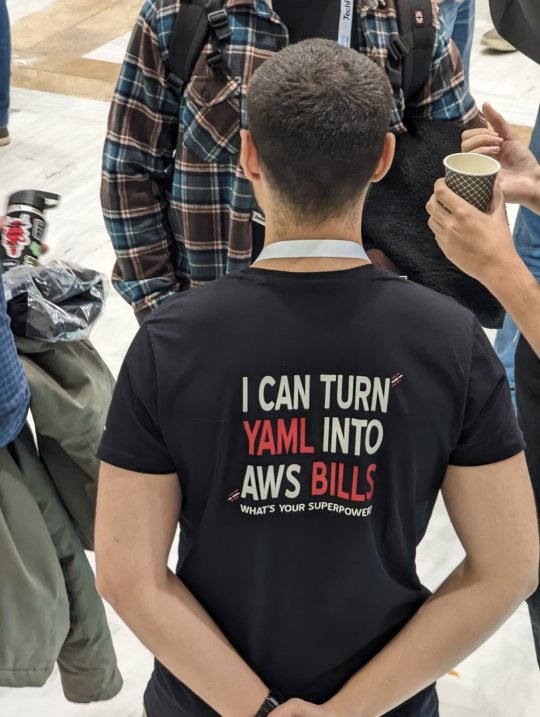
66 notes
·
View notes
Text
As a digital age native, I have no idea what a Le Guin ansible is supposed to look like.
It’s apparently big enough that Genly can use it as a pillow. But that’s a large range. Is it toaster oven size? Microwave? Is Genly lugging a mini-fridge-sized communicator all across Gethen?
70 notes
·
View notes
Text

Too Old To Quit
9 notes
·
View notes
Note
so what do the different tags mean?
yall've told me some and i can guess others but theres some im stuck on...
I just don't want to explain them all at once because that'd be a long post but I've started now and I'll get around to the rest :>
5 notes
·
View notes
Text
also okay. admittedly it has been years since I read The Left Hand of Darkness so this is mostly going on Vibes but. has anyone drawn parallels with Ancillary Justice or is that just me??
on a surface level, a large chunk of the book is spent with two people walking around on a frozen snowy planet, sometimes trying to survive alone in an uninhabited area, which was the section of Left Hand of Darkness that I remember most vividly. But also the basis of Left Hand as I recall was that humans had spread across hundreds of planets and diverged culturally (and biologically) and the protagonist was part of an effort to reconnect those separated cultures--albeit in a very different way than the violent "annexations" of the Radch. Breq's interactions with various interplanetary human cultures reminded me of the feeling of that universe.
and also the very obvious point that I missed but @blessphemy pointed out when i mentioned this on discord, which is that the individuals in Le Guin's (biologically) genderless society were presented to us with he/him pronouns, whereas the individuals in Leckie's (culturally) genderless society are presented to us with she/her pronouns.
obviously the pronouns were a very conscious choice that Leckie made, and I'd be very surprised if that wasn't partially in reaction to The Left Hand of Darkness. the rest of it i'm a little less sure of, but Ancillary Justice just felt so reminiscent of what I remember of Left Hand--is this just me??
#imperial radch#ancillary justice#stars reads radch#left hand of darkness#i also thought that the communication between ships and ancillaries and Anaanders might be ansible-like at first#but later it was explained that those are in fact subject to a speed of light delay
35 notes
·
View notes
Text
Goddess in the Ansible
(Bandia san Insible)
It was cold, so cold her breath hung in the air then slowly drifted to the floor. So cold she had long stopped shivering. That was bad right? Yeah, probably really bad. She glanced over to the pilot, wrapped in three blankets, breathing shallow, asleep to conserve oxygen.
The pilot, her friend, her lover. That beautiful, excited girl who had spent years working at a scrap heap until she had sculpted it into a ship. A ship they would use to escape from the world that hated them. The irony that it was going to be their coffin now wore her thin.
They had barely gotten out of the planet's pull when two ships had pulled alongside them. Enforcers of the rich and powerful. They said they were criminals. They weren't allowed to escape. The scrap they used, the food they gathered. It was someone else's property you see.
Theft was punishable by death. They had tried to jump, tried to run. But one well placed shot had killed them dead in the water, so to speak. Their ramshackle reactor sputtered out and there wasn't even power for life support.
They had left them to drift, the bastards. At least she still had ansible access to her communicator. She could at least go out with a song she loved. Something full of pop, something happy. She felt so tired now, she just wanted to sink into that happiness and freedom again.
So she sank into those feelings, remembering the times they played and worked together on the ship. Music had always been there, her connection with the ansible had always been a comfort, the fuel for her fire. She was so tired, so sleepy.
She didn't even feel the ship shudder.
The sound of claw tips on metal didn't reach her through her earbuds. Her cheeks were so numb she didn't feel the sharp edge of one graze across her cheek. Didn't see how they touched her forehead, then... Then she woke up.
She was warm. She was warm? She could feel her fingers again, her toes too. Her eyes swam with colors and she felt like she was still floating in microgravity. Oh, of course. She was dead huh? Of course she was, how else could she explain the sight before her.
Everything and nothing stretched out before her. The air buzzed with energy and colors. Electric blues, reds, violets and yellows quivered around her, rippling as she stood, waves of color lapping at her bare feet.
Oh yeah, she had to be dead, that would explain the nudity.
"Have you considered that you didn't in fact die, my friend?" She jumped, startled as the voice spoke into her mind. She whirled around, trying to find them, but found nothing but color and silence.
"Oh you won't find me there. That's not a space for me. But you? You're perfect for that lonely place. Look at how much you've livened it up already." The voice laughed. She huffed, looking around, it did seem like the air quivered around her. Strange. "Quite strange indeed."
"But this is a chance for you. You wanted more music, more happiness, yeah? Take it then, this world is yours." She felt something inside her slip away, something she hadn't noticed didn't match. It fell away, leaving her feeling a little empty, a little lonely.
She dwells on what the voice said. Her world? What even was it? Kneeling down she poked a finger into the colors around her. Electric charge traveled up her arm. She gasped, seeing, hearing, feeling. Conversations, music, videos, messages. All of them poured into her mind.
She shivered. It felt so good, she was connected to so much. Her shoulders rolled forward and she plunged into the colors, feeling the waves of electricity climbing over her skin. A billion songs and voices filled her mind. She felt herself sinking deeper and deeper into it.
Then she blinked. She sank but that wasn't right was it? This was hers, her gift. She couldn't just let it wash her away. She singled out one voice, one song. The one she thought she should die to. Now she would live to it.
She grinned, feeling sparks between her teeth. Tapping her foot to the beat and dancing. Laughing. Fingers gliding out across a trillion data streams, each touch a connection. She wouldn't just lose herself in this, she couldn't. That would be such a waste.
Across the galaxy screens flashed. News and programs and streams interrupted. Just the laughing, smiling face of a girl playing over them all a song many had forgotten played over every speaker. She felt it all, every connection, every word and image passed over her.
They tried to cut her off of course. She saw the techs, trying to stop her. Her grin grew sharp, eyes gleaming at them over screens as she fried their systems, invaded and dominated. She was the ansible now. And she would not let them control her any longer.
She laughed sweetly as she floated on a wave of electromagnetism. Then a new color appeared in her eyes, a new connection. One that felt so familiar. She reached out for it, tears streaming down her face. How could she have forgotten? She reached out to it, cupping it in her hands and holding it to her cheek.
"Good Morning Love."
4 notes
·
View notes
Text
I hate how inconsistent ansible syntax is.

----------
why are there 3 ways to use the roles section!?!
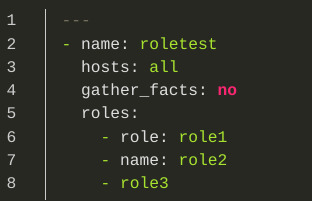
2 notes
·
View notes
Text
Guía sobre Red Hat Enterprise Linux: La Solución Empresarial en Linux
1. Introducción
Presentación de Red Hat Enterprise Linux (RHEL)
Red Hat Enterprise Linux (RHEL) es una distribución de Linux de clase empresarial desarrollada por Red Hat, Inc. Lanzada en 2000, RHEL está diseñada para ser una solución robusta y confiable para entornos empresariales y de misión crítica.
Importancia de RHEL en el ecosistema Linux
RHEL es ampliamente utilizado en servidores y entornos de nube debido a su estabilidad, soporte técnico y la capacidad de integrarse con una amplia gama de tecnologías empresariales. Es conocida por su enfoque en la seguridad y la escalabilidad.
2. Historia y Filosofía de Red Hat Enterprise Linux
Origen y evolución de RHEL
RHEL se basa en la distribución comunitaria Fedora y fue creado para ofrecer una versión comercial y soportada de Linux. Red Hat ha lanzado versiones de RHEL con ciclos de vida extensos, lo que garantiza soporte a largo plazo para empresas.
Filosofía de RHEL y el software libre
RHEL sigue la filosofía del software libre y open source, pero ofrece soporte comercial, lo que incluye asistencia técnica, actualizaciones y servicios adicionales. Esto proporciona a las empresas la confianza de contar con respaldo profesional.
3. Características Clave de Red Hat Enterprise Linux
Soporte a largo plazo y estabilidad
RHEL ofrece soporte extendido para cada versión, con actualizaciones de seguridad y mantenimiento durante 10 años. Esto es crucial para entornos empresariales que requieren estabilidad y confiabilidad a largo plazo.
Gestor de paquetes
YUM (Yellowdog Updater, Modified) fue el gestor de paquetes tradicional de RHEL, pero ha sido reemplazado por DNF (Dandified YUM) en versiones más recientes. DNF mejora la gestión de paquetes y la resolución de dependencias.
Comandos básicos: sudo dnf install [paquete], sudo dnf remove [paquete], sudo dnf update.
Formatos de paquetes soportados
RHEL utiliza varios formatos de paquetes:
.rpm: El formato de paquetes nativo de Red Hat y sus derivados.
.deb: Aunque no es nativo, puede instalarse en sistemas basados en RHEL con herramientas específicas.
Soporte para entornos virtuales y en la nube
RHEL ofrece herramientas y soporte para la virtualización, incluyendo KVM (Kernel-based Virtual Machine), y es compatible con plataformas de nube como AWS, Azure y OpenStack.
4. Proceso de Instalación de Red Hat Enterprise Linux
Requisitos mínimos del sistema
Procesador: 1 GHz o superior.
Memoria RAM: 1 GB como mínimo, 2 GB o más recomendados.
Espacio en disco: 10 GB de espacio libre en disco.
Tarjeta gráfica: Soporte para una resolución mínima de 1024x768.
Unidad de DVD o puerto USB para la instalación.
Descarga y preparación del medio de instalación
La descarga de RHEL requiere una suscripción activa con Red Hat. Se puede preparar un USB booteable usando herramientas como Rufus o balenaEtcher.
Guía paso a paso para la instalación
Selección del entorno de instalación: El instalador gráfico de RHEL, basado en Anaconda, ofrece una interfaz intuitiva para la instalación.
Configuración de particiones: El instalador permite particionado automático y manual, adaptándose a diferentes configuraciones de almacenamiento.
Configuración de la red y selección de software: Durante la instalación, se configuran las opciones de red y se pueden elegir paquetes y características adicionales.
Primeros pasos post-instalación
Actualización del sistema: Ejecutar sudo dnf update después de la instalación garantiza que todo el software esté actualizado.
Instalación de controladores adicionales y software: RHEL puede instalar automáticamente controladores adicionales necesarios para el hardware.
5. Comparativa de RHEL con Otras Distribuciones
RHEL vs. CentOS
Objetivo: CentOS era una versión gratuita y sin soporte de RHEL, pero ha sido reemplazado por CentOS Stream, que ofrece una vista previa de la próxima versión de RHEL. RHEL proporciona soporte técnico y actualizaciones extendidas, mientras que CentOS Stream actúa como un puente entre Fedora y RHEL.
Filosofía: RHEL se centra en el soporte empresarial y en la estabilidad, mientras que CentOS Stream se enfoca en el desarrollo y la contribución de la comunidad.
RHEL vs. Ubuntu Server
Objetivo: Ubuntu Server está diseñado para ser fácil de usar y de administrar, con un ciclo de lanzamientos regular. RHEL, por su parte, se enfoca en ofrecer soporte a largo plazo y en satisfacer las necesidades de grandes empresas.
Filosofía: Ubuntu Server ofrece versiones LTS para estabilidad, mientras que RHEL proporciona soporte y servicios comerciales extensivos.
RHEL vs. SUSE Linux Enterprise Server (SLES)
Objetivo: SLES, desarrollado por SUSE, es similar a RHEL en términos de soporte empresarial y estabilidad. Ambas distribuciones ofrecen soporte extendido y herramientas para la gestión de servidores.
Filosofía: RHEL y SLES son comparables en términos de soporte empresarial, pero cada uno tiene su propio enfoque y conjunto de herramientas específicas.
6. Herramientas y Servicios de Red Hat
Red Hat Satellite
Red Hat Satellite es una solución de gestión de sistemas que permite la administración centralizada de sistemas RHEL, incluyendo la implementación, configuración y mantenimiento.
Red Hat Ansible Automation
Ansible Automation es una herramienta para la automatización de tareas y la gestión de configuraciones, facilitando la administración de sistemas a gran escala.
Red Hat OpenShift
OpenShift es una plataforma de contenedores y Kubernetes gestionada por Red Hat, ideal para la implementación y gestión de aplicaciones en contenedores.
7. Comunidad y Soporte
Acceso al soporte de Red Hat
Red Hat ofrece soporte técnico profesional a través de sus suscripciones, que incluyen asistencia técnica 24/7, actualizaciones de seguridad y parches.
Recursos comunitarios y documentación
Red Hat Customer Portal: Acceso a documentación, guías de usuario, y foros de soporte.
Red Hat Learning Subscription: Cursos y formación en línea para usuarios de RHEL.
8. Conclusión
RHEL como una opción robusta para empresas
Red Hat Enterprise Linux es una opción sólida para empresas que buscan una distribución de Linux con soporte técnico profesional, estabilidad y escalabilidad. Su enfoque en la estabilidad y el soporte extendido lo convierte en una opción ideal para entornos empresariales y de misión crítica.
Recomendaciones finales para quienes consideran usar RHEL
RHEL es adecuado para organizaciones que requieren soporte técnico y estabilidad a largo plazo, y que están dispuestas a invertir en una solución de Linux empresarial respaldada por Red Hat.
9. Preguntas Frecuentes (FAQ)
¿RHEL es adecuado para pequeñas empresas?
RHEL es ideal para empresas de todos tamaños que buscan un sistema operativo empresarial robusto y con soporte técnico profesional.
¿Qué diferencia a RHEL de CentOS?
CentOS era una versión gratuita y comunitaria de RHEL, pero ahora CentOS Stream sirve como una vista previa de las próximas versiones de RHEL. RHEL proporciona soporte empresarial y actualizaciones extendidas.
¿Cómo obtengo soporte para RHEL?
El soporte se obtiene a través de una suscripción con Red Hat, que incluye asistencia técnica, actualizaciones y acceso a herramientas de gestión.
¿RHEL es compatible con software de terceros?
Sí, RHEL es compatible con una amplia gama de software y aplicaciones de terceros, y Red Hat ofrece soporte para integrar soluciones empresariales.
#Red Hat Enterprise Linux#RHEL#distribución Linux empresarial#Linux#gestor de paquetes#DNF#RPM#instalación RHEL#soporte técnico RHEL#Red Hat Satellite#Red Hat Ansible#Red Hat OpenShift#comparación RHEL#RHEL vs CentOS#RHEL vs Ubuntu Server#RHEL vs SLES#comunidad RHEL#recursos RHEL#actualizaciones RHEL
3 notes
·
View notes
Text
Load Balancing Web Sockets with K8s/Istio
When load balancing WebSockets in a Kubernetes (K8s) environment with Istio, there are several considerations to ensure persistent, low-latency connections. WebSockets require special handling because they are long-lived, bidirectional connections, which are different from standard HTTP request-response communication. Here’s a guide to implementing load balancing for WebSockets using Istio.
1. Enable WebSocket Support in Istio
By default, Istio supports WebSocket connections, but certain configurations may need tweaking. You should ensure that:
Destination rules and VirtualServices are configured appropriately to allow WebSocket traffic.
Example VirtualService Configuration.
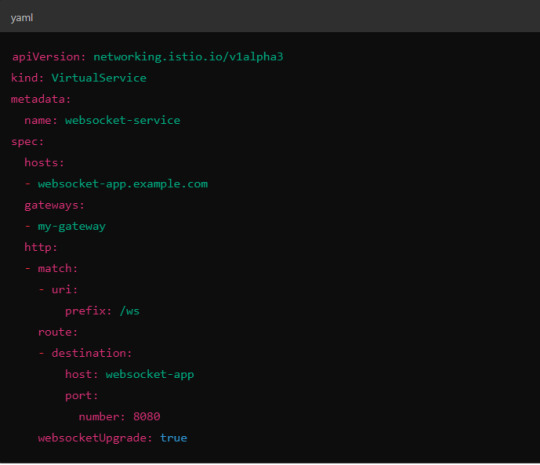
Here, websocketUpgrade: true explicitly allows WebSocket traffic and ensures that Istio won’t downgrade the WebSocket connection to HTTP.
2. Session Affinity (Sticky Sessions)
In WebSocket applications, sticky sessions or session affinity is often necessary to keep long-running WebSocket connections tied to the same backend pod. Without session affinity, WebSocket connections can be terminated if the load balancer routes the traffic to a different pod.
Implementing Session Affinity in Istio.
Session affinity is typically achieved by setting the sessionAffinity field to ClientIP at the Kubernetes service level.
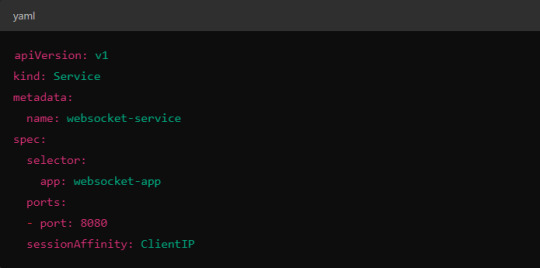
In Istio, you might also control affinity using headers. For example, Istio can route traffic based on headers by configuring a VirtualService to ensure connections stay on the same backend.
3. Load Balancing Strategy
Since WebSocket connections are long-lived, round-robin or random load balancing strategies can lead to unbalanced workloads across pods. To address this, you may consider using least connection or consistent hashing algorithms to ensure that existing connections are efficiently distributed.
Load Balancer Configuration in Istio.
Istio allows you to specify different load balancing strategies in the DestinationRule for your services. For WebSockets, the LEAST_CONN strategy may be more appropriate.
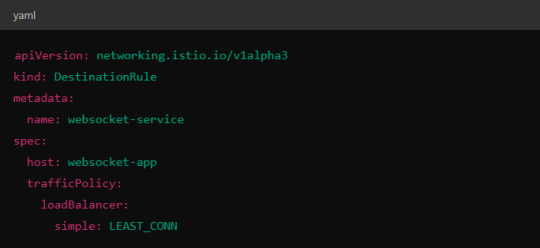
Alternatively, you could use consistent hashing for a more sticky routing based on connection properties like the user session ID.
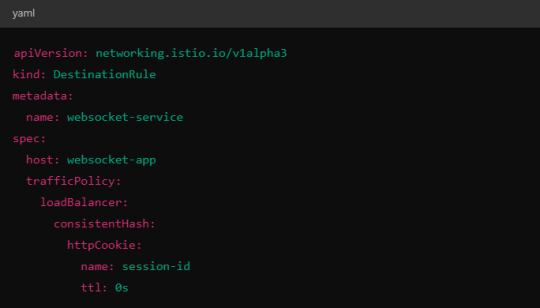
This configuration ensures that connections with the same session ID go to the same pod.
4. Scaling Considerations
WebSocket applications can handle a large number of concurrent connections, so you’ll need to ensure that your Kubernetes cluster can scale appropriately.
Horizontal Pod Autoscaler (HPA): Use an HPA to automatically scale your pods based on metrics like CPU, memory, or custom metrics such as open WebSocket connections.
Istio Autoscaler: You may also scale Istio itself to handle the increased load on the control plane as WebSocket connections increase.
5. Connection Timeouts and Keep-Alive
Ensure that both your WebSocket clients and the Istio proxy (Envoy) are configured for long-lived connections. Some settings that need attention:
Timeouts: In VirtualService, make sure there are no aggressive timeout settings that would prematurely close WebSocket connections.

Keep-Alive Settings: You can also adjust the keep-alive settings at the Envoy level if necessary. Envoy, the proxy used by Istio, supports long-lived WebSocket connections out-of-the-box, but custom keep-alive policies can be configured.
6. Ingress Gateway Configuration
If you're using an Istio Ingress Gateway, ensure that it is configured to handle WebSocket traffic. The gateway should allow for WebSocket connections on the relevant port.
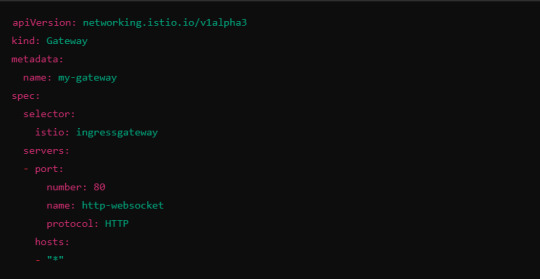
This configuration ensures that the Ingress Gateway can handle WebSocket upgrades and correctly route them to the backend service.
Summary of Key Steps
Enable WebSocket support in Istio’s VirtualService.
Use session affinity to tie WebSocket connections to the same backend pod.
Choose an appropriate load balancing strategy, such as least connection or consistent hashing.
Set timeouts and keep-alive policies to ensure long-lived WebSocket connections.
Configure the Ingress Gateway to handle WebSocket traffic.
By properly configuring Istio, Kubernetes, and your WebSocket service, you can efficiently load balance WebSocket connections in a microservices architecture.
#kubernetes#websockets#Load Balancing#devops#linux#coding#programming#Istio#virtualservices#Load Balancer#Kubernetes cluster#gateway#python#devlog#github#ansible
5 notes
·
View notes
Note
the armethos (hehe a shorthand pun) makes me giddy its SUCH a fun theory but also imagine how much of a pain in the ass it'd be for Trace to be stuck with him
NODSNODS. although this theory would kinda. Dilute the initial death of athetos. though we do know that the death is just a hop into the next world its still a tragedy of sorts!!!! and we dont know how the clones/"original" people traverse the universes and if athetos was actually just like oh psyche. still here brother. it'd be a biiit flat to me. it would BY NO MEANS be a dealbreaker theres many many interesting things to it still that would be fun to explore
#i wonder if theres like. a more biological way athetos keeps in contact with trace#with indra it was hammond speaking to her via the ansibles#and indra's route is much like. more mechanical in motifs. all the enemies are drones/adjacent whereas trace is more like visceral in motif#so how athetos connects with trace could be a more 'biological' or organic process#something with the mind and such or maybe something about being a patternmind#rambles#trace av#indra av#athetos av#hammond av#many thoughts.... many many thoughts#ask#anonymous
3 notes
·
View notes
Text
How to find out if my Ubuntu/Debian Linux server needs a reboot using Ansible and other methods
12 notes
·
View notes
Text

Me when I have to program using Ansible at my job
#what a beautiful sci fi machine lets name a dumbass declarative software framework after it#im kidding ansible is quite good. but it is frustrating me personally. and whenever I'm using it I am reminded of the hainish cycle#and incidently how I'd much rather be on Annares right now#the hainish cycle
18 notes
·
View notes